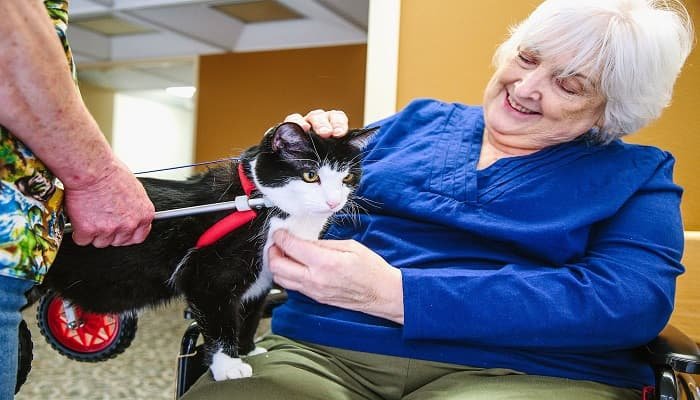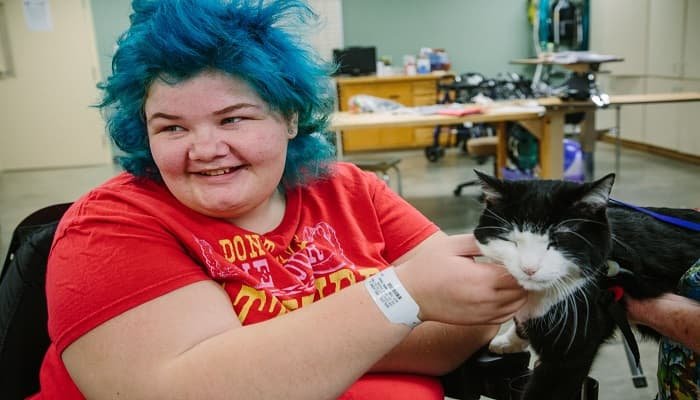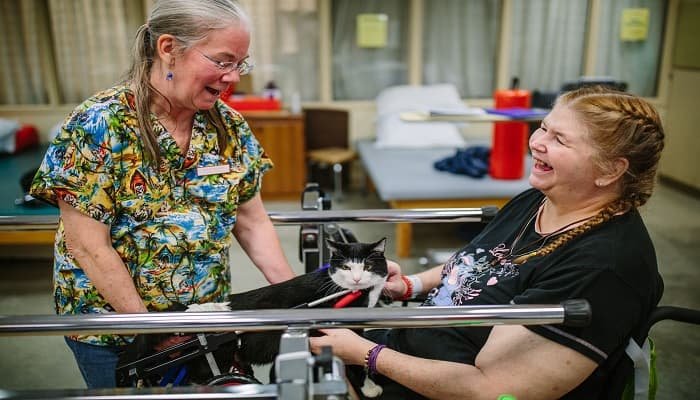PITTSBURGH, PENNSYLVANIA – Scooter strides down the hospital hallway as if he owns the place, front legs trotting quickly and back wheels spinning briskly, propelling the platform which supports the cat’s paralyzed hind legs.
“Who wants to say hi to Scooter?” asked Betsy Kennon, the veterinarian who saved the cat’s life just eight years ago and then took him to her Natrona Heights home.
“I do!” said Melanie Wiler, the first to answer the question addressed to patients in a large therapy room located at HealthSouth Harmarville Rehabilitation Hospital.
Veterinarian Betsy Kennon’s cat Scooter, who is paralyzed and uses a wheelchair loves to visit patients at Healthsouth Harmarville Rehabilitation Hospital.
“I love cats,” said Ms. Wiler, of Pittsfield, Warren County. “I have two at home — Mocha and Carmel.” But, she added, “Scooter is inspirational. He is in a wheelchair, and I am in a wheelchair. If he can do it, I can do it.”
”Scooter’s disability is not a handicap,” Dr. Kennon tells patients. The black-and-white tuxedo cat “doesn’t want to be pitied or helped. Scooter wants to be as much as he can be — by himself.”
Every Wednesday for the past eight years, the therapy cat has accompanied Dr. Kennon to HealthSouth. Many of the patients there are in wheelchairs, rehabilitating from strokes, accidents or amputations.
Therapy animals such as Scooter relieve stress and make people smile.
Scooter also serves as a therapy cat for the staffmmbers.
“I am his best friend,” said Robert Totten, a rehabilitation therapy technician. “Scooter is an amazing miracle.”
Dr. Kennon, a veterinarian at VCA Northview Animal Hospital in Ross, often picks up her cat and puts him in the laps of patients.
“You can pet him anywhere, except his feet,” she tells patients. ”Even then, he would just pull his feet away.He would never hiss, bite or scratch.”
Scooter also never meows or purrs while he’s working, which is at least two days each and every week. Dr. Kennon can tell he’s happy and never stressed during therapy visits because his ears are up and he makes eye contact with his big, yellow eyes with patients and staff.
Scooter was just 6 months old, an apparent stray, when a tearful client brought him to the veterinary clinic. He said his Siberian husky brought the kitten home, and at first, the client thought his dog had nearly killed it.
The kitten was in shock and was not able not move his back legs, but there were no signs of bite marks.
“I think the dog saved the kitten’s life,” Dr. Kennon said. A vertebrae had been crushed. It’s possible he had been hit by a car.
At home Scooter lives a “normal” cat life, getting along with three big dogs. He doesn’t use the wheelchair at home — he scoots around the house using the front end of his body. He wears a baby diaper which protects his back end from the friction of carpets and floors.
Scooter runs, but he isn’t able to jump. He goes up and down carpeted stairs. He can get up on couches, but he can’t get himself up onto beds at all because they are too high. However, he has killed six mice in the basement.
Scooter’s other “work” includes a monthly visit to Heritage Hospice located in New Kensington and weekly visits to Oakmont Center for Nursing and Rehabilitation, Golden Living Center in Murrysville, Concordia at Cabot and also Platinum Ridge Center for Rehabilitation and Healing in Brackenridge.
Although therapy dogs are most common, therapy cats are not numerous, so Scooter has become somewhat of a celebrity everywhere he goes. Back in 2012, he was named the ASPCA Cat of the Year.
In August 2010, he was just one of six animals featured in a Reader’s Digest cover story titled “Amazing Pets.”
Video and photo by Andrew Rush, 3/24/2016













